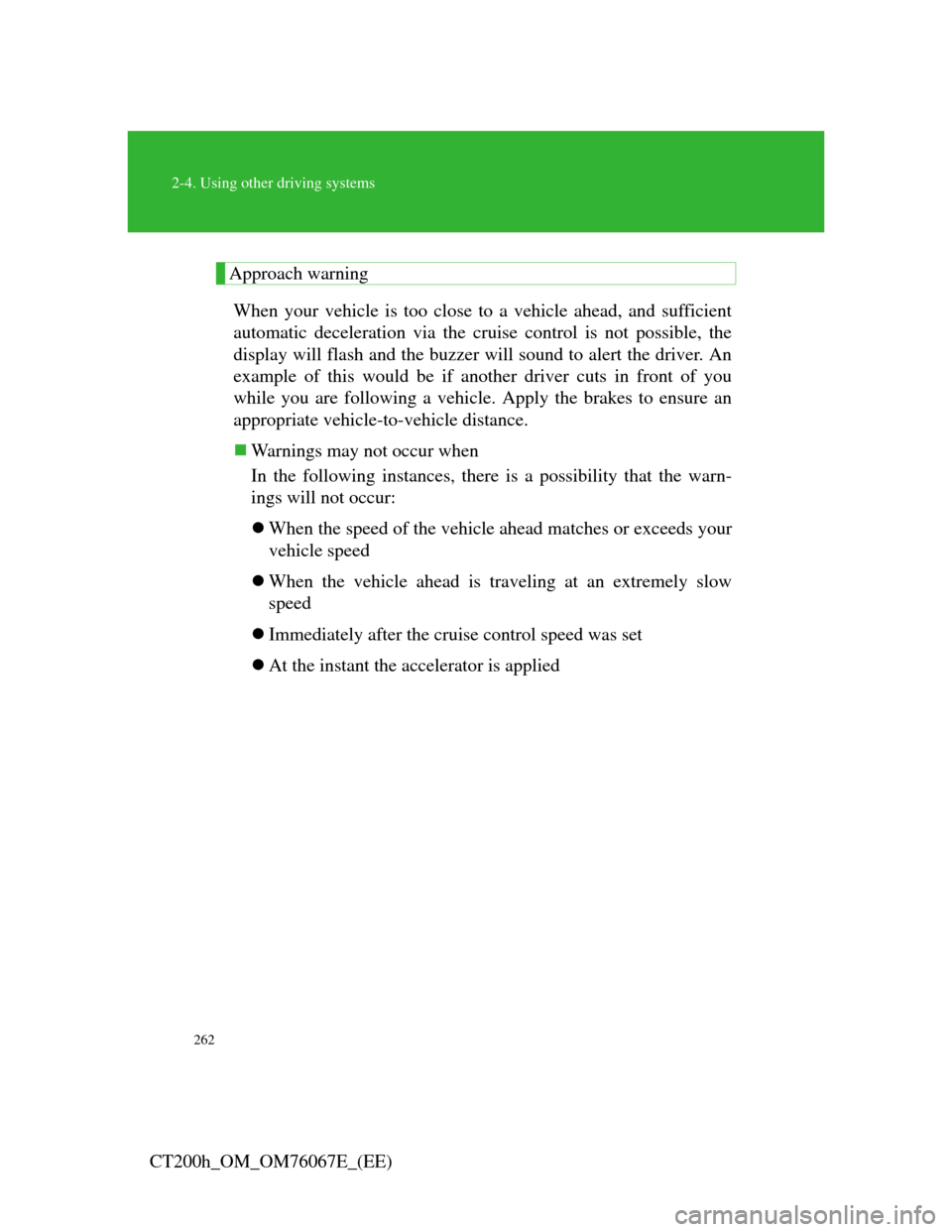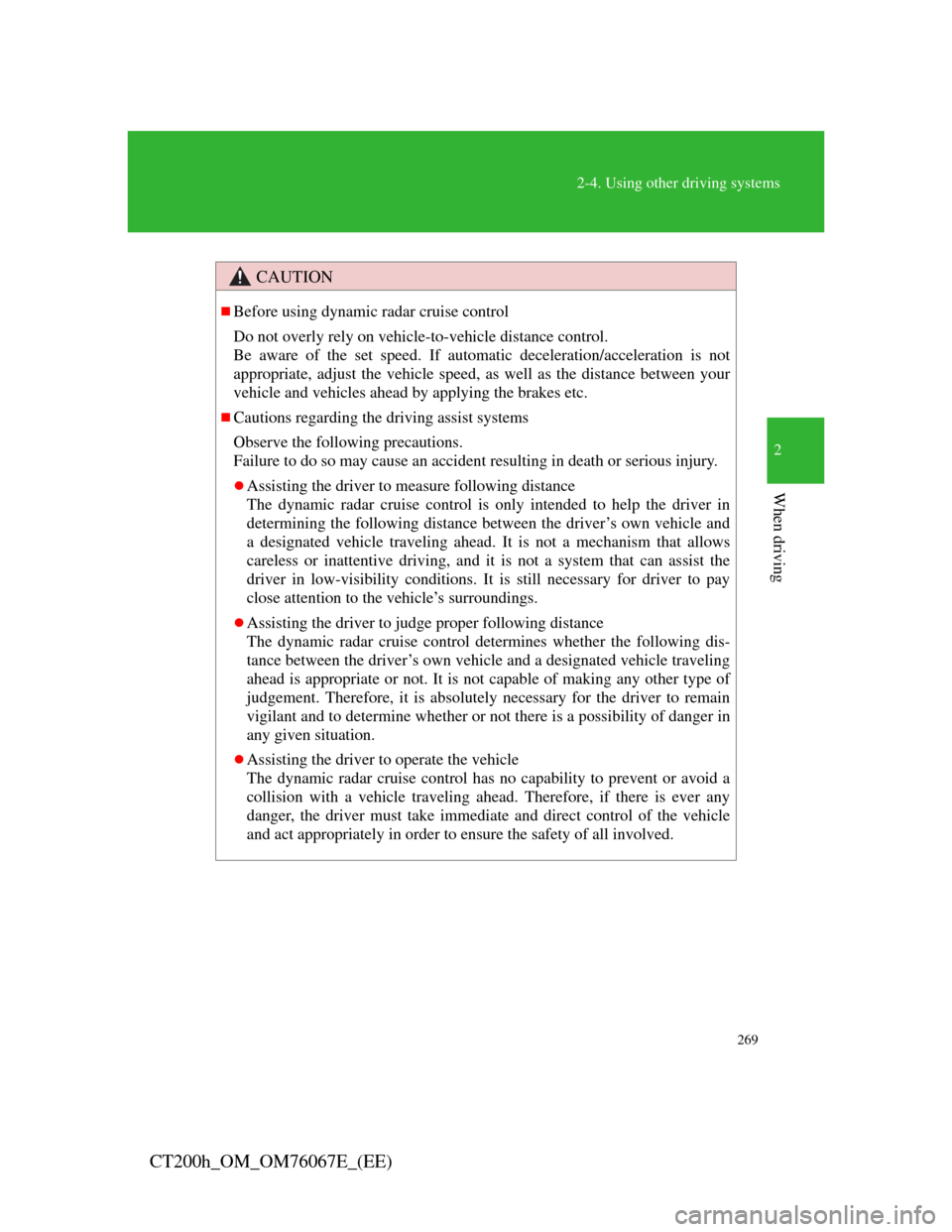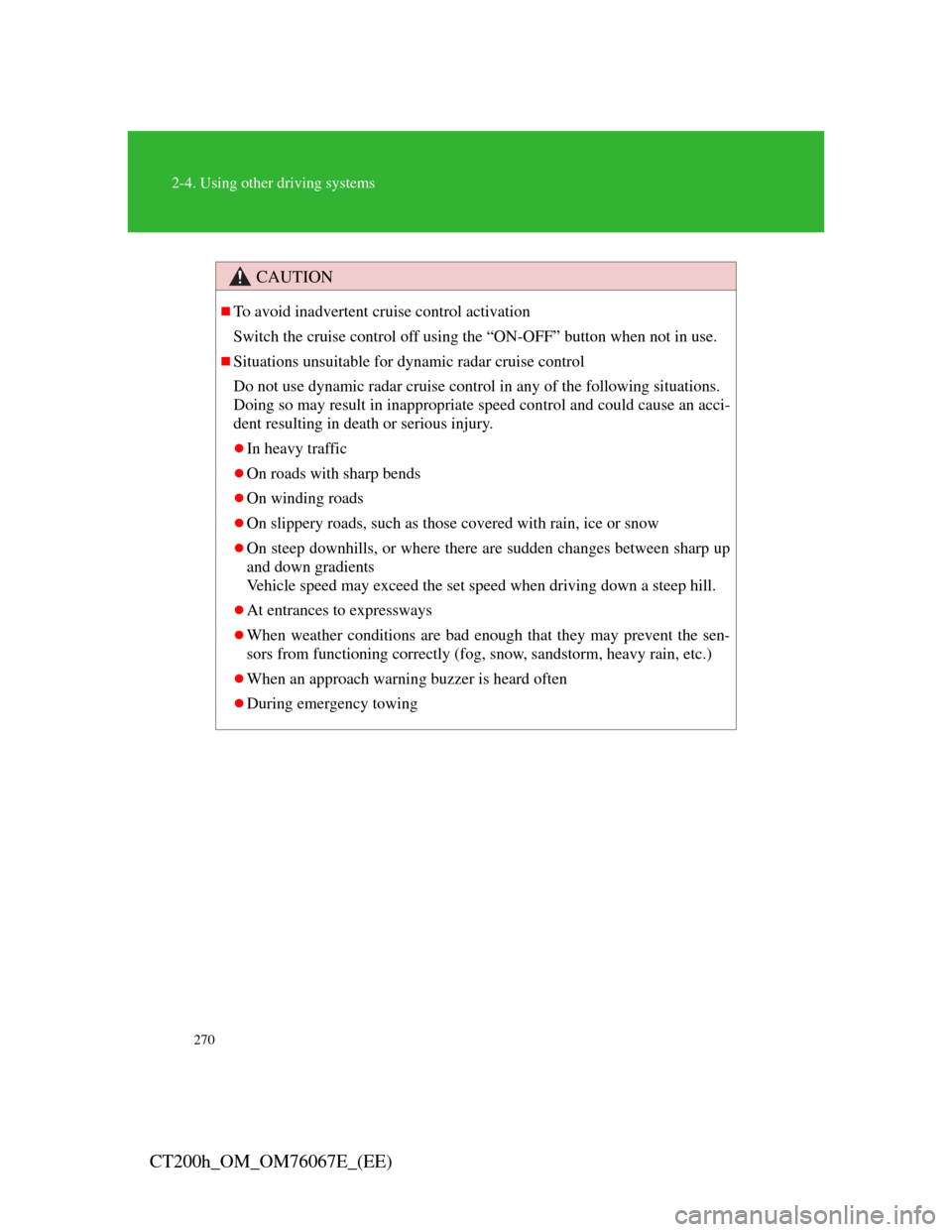Lexus CT200h 2012 Owner's Manual (in English)
Manufacturer: LEXUS, Model Year: 2012, Model line: CT200h, Model: Lexus CT200h 2012Pages: 710
Page 261 of 710

261
2-4. Using other driving systems
2
When driving
CT200h_OM_OM76067E_(EE)Example of constant speed cruising
When there are no vehicles ahead
The vehicle travels at the speed set by the driver. The desired vehicle-
to-vehicle distance can also be set by operating the vehicle-to-vehicle
distance control.
Example of deceleration cruising
When the vehicle ahead is driving slower than the set speed
When a vehicle is detected running ahead of you, the system automat-
ically decelerates your vehicle. When a greater reduction in vehicle
speed is necessary, the system applies the brakes. A warning tone
warns you when the system cannot decelerate sufficiently to prevent
your vehicle from closing in on the vehicle ahead.
Example of follow-up cruising
When following a vehicle driving slower than the set speed
The system continues follow-up cruising while adjusting for changes
in the speed of the vehicle ahead in order to maintain the vehicle-to-
vehicle distance set by the driver.
Example of acceleration
When there are no longer any vehicles ahead driving slower than
the set speed
The system accelerates until the set speed is reached. The system then
returns to constant speed cruising.
Page 262 of 710

262
2-4. Using other driving systems
CT200h_OM_OM76067E_(EE)
Approach warning
When your vehicle is too close to a vehicle ahead, and sufficient
automatic deceleration via the cruise control is not possible, the
display will flash and the buzzer will sound to alert the driver. An
example of this would be if another driver cuts in front of you
while you are following a vehicle. Apply the brakes to ensure an
appropriate vehicle-to-vehicle distance.
Warnings may not occur when
In the following instances, there is a possibility that the warn-
ings will not occur:
When the speed of the vehicle ahead matches or exceeds your
vehicle speed
When the vehicle ahead is traveling at an extremely slow
speed
Immediately after the cruise control speed was set
At the instant the accelerator is applied
Page 263 of 710

263
2-4. Using other driving systems
2
When driving
CT200h_OM_OM76067E_(EE)
Selecting conventional constant speed control mode
Constant speed control mode differs from vehicle-to-vehicle dis-
tance control mode. When constant speed control mode is selected,
your vehicle will maintain a set speed regardless of whether or not
there are other vehicles in the lane ahead.
Press the “ON-OFF” button
to activate the cruise control.
Press the button again to deacti-
vate the cruise control.
Switch to constant speed
control mode.
(Push the lever forward and
hold for approximately one
second.)
Cruise control indicator will
come on.
When in constant speed control
mode, to return to vehicle-to-
vehicle distance control mode,
push the lever forward again
and hold for approximately 1
second.
Page 264 of 710

264
2-4. Using other driving systems
CT200h_OM_OM76067E_(EE)
After the desired speed has been
set, it is not possible to return to
vehicle-to-vehicle distance con-
trol mode.
If the “POWER” switch is
turned off and then turned to
ON mode again, the vehicle will
automatically return to vehicle-
to-vehicle distance control
mode.
Adjusting the speed setting:
P. 2 5 7
Canceling and resuming the
speed setting: P. 259
Page 265 of 710

265
2-4. Using other driving systems
2
When driving
CT200h_OM_OM76067E_(EE)
Dynamic radar cruise control can be set when
The shift position is in D.
Vehicle speed is above approximately 50 km/h (30 mph).
Accelerating after setting the vehicle speed
The vehicle can accelerate normally. After acceleration, the set speed
resumes. However, during vehicle-to-vehicle distance control mode, the
vehicle speed may decrease below the set speed in order to maintain the dis-
tance to the vehicle ahead.
Set speed
The set speed may be unsustainable depending on driving circumstances.
Automatic cancelation of vehicle-to-vehicle distance control
Vehicle-to-vehicle distance control driving is automatically canceled in the
following situations:
Actual vehicle speed falls below approximately 40 km/h (25 mph).
VSC is activated.
The sensor cannot operate correctly because it is covered in some way.
The windshield wipers are operating at high speed (when the wiper
switch is set to the “AUTO” mode or the high speed wiper operation
position).
If vehicle-to-vehicle distance control driving is automatically canceled for
any other reason, there may be a malfunction in the system. Contact any
authorized Lexus dealer or repairer, or another duly qualified and equipped
professional.
Page 266 of 710

266
2-4. Using other driving systems
CT200h_OM_OM76067E_(EE)
Automatic cancelation of constant speed control
The cruise control will stop maintaining the vehicle speed in the following
situations:
Actual vehicle speed is more than approximately 16 km/h (10 mph)
below the set vehicle speed.
At this time, the memorized set speed is not retained.
Vehicle speed falls below approximately 40 km/h (25 mph).
VSC is activated.
Radar sensor and grille cover
Always keep the sensor and grille cover clean to ensure that the vehicle-to-
vehicle distance control operates properly. (Some obstructions, such as
snow, ice and plastic objects, cannot be detected by the obstruction sensor.)
Dynamic radar cruise control is canceled if an obstruction is detected.
Warning messages and buzzers for dynamic radar cruise control
Warning messages and buzzers are used to indicate a system malfunction or
to inform the driver of the need for caution while driving.
(P. 578)
Grille cover
Radar sensor
Page 267 of 710

267
2-4. Using other driving systems
2
When driving
CT200h_OM_OM76067E_(EE)
Certification
Page 268 of 710

268
2-4. Using other driving systems
CT200h_OM_OM76067E_(EE)
Page 269 of 710

269
2-4. Using other driving systems
2
When driving
CT200h_OM_OM76067E_(EE)
CAUTION
Before using dynamic radar cruise control
Do not overly rely on vehicle-to-vehicle distance control.
Be aware of the set speed. If automatic deceleration/acceleration is not
appropriate, adjust the vehicle speed, as well as the distance between your
vehicle and vehicles ahead by applying the brakes etc.
Cautions regarding the driving assist systems
Observe the following precautions.
Failure to do so may cause an accident resulting in death or serious injury.
Assisting the driver to measure following distance
The dynamic radar cruise control is only intended to help the driver in
determining the following distance between the driver’s own vehicle and
a designated vehicle traveling ahead. It is not a mechanism that allows
careless or inattentive driving, and it is not a system that can assist the
driver in low-visibility conditions. It is still necessary for driver to pay
close attention to the vehicle’s surroundings.
Assisting the driver to judge proper following distance
The dynamic radar cruise control determines whether the following dis-
tance between the driver’s own vehicle and a designated vehicle traveling
ahead is appropriate or not. It is not capable of making any other type of
judgement. Therefore, it is absolutely necessary for the driver to remain
vigilant and to determine whether or not there is a possibility of danger in
any given situation.
Assisting the driver to operate the vehicle
The dynamic radar cruise control has no capability to prevent or avoid a
collision with a vehicle traveling ahead. Therefore, if there is ever any
danger, the driver must take immediate and direct control of the vehicle
and act appropriately in order to ensure the safety of all involved.
Page 270 of 710

270
2-4. Using other driving systems
CT200h_OM_OM76067E_(EE)
CAUTION
To avoid inadvertent cruise control activation
Switch the cruise control off using the “ON-OFF” button when not in use.
Situations unsuitable for dynamic radar cruise control
Do not use dynamic radar cruise control in any of the following situations.
Doing so may result in inappropriate speed control and could cause an acci-
dent resulting in death or serious injury.
In heavy traffic
On roads with sharp bends
On winding roads
On slippery roads, such as those covered with rain, ice or snow
On steep downhills, or where there are sudden changes between sharp up
and down gradients
Vehicle speed may exceed the set speed when driving down a steep hill.
At entrances to expressways
When weather conditions are bad enough that they may prevent the sen-
sors from functioning correctly (fog, snow, sandstorm, heavy rain, etc.)
When an approach warning buzzer is heard often
During emergency towing